The Essential Role of Mortuary Chambers in Modern Funeral Services
When a loved one passes away, time seems to stand still for the family—but biology continues its inevitable course. This is where a mortuary chamber steps in, serving as a guardian of dignity during life's most difficult transition.
A mortuary chamber is essentially a specialized refrigerated unit designed specifically for preserving human remains. By maintaining carefully controlled low temperatures, these chambers slow decomposition and inhibit bacterial growth, creating a respectful bridge between death and final arrangements.
For funeral homes, hospitals, medical examiners' offices, and disaster response teams, these chambers aren't just equipment—they're essential infrastructure that allows professionals to provide families with time and space for proper goodbyes.
| Mortuary Chamber Quick Facts |
|---|
| Primary Purpose: Preserve human remains by maintaining temperatures between -5°C to +10°C |
| Common Types: Single-body, 3-body, 6-body, and walk-in chambers |
| Key Features: Stainless steel construction, polyurethane insulation, digital temperature controls |
| Typical Applications: Funeral homes, hospitals, forensic labs, disaster response |
| Average Cost: $6,000-$10,000 for standard units, custom solutions vary |
Beyond their technical function, mortuary chambers serve a profound public health purpose. They prevent the potential spread of disease while ensuring that even in death, a person is treated with the utmost respect and care. These specialized units create a window of time—precious days that allow families to gather, religious ceremonies to be arranged, and legal requirements to be fulfilled.
Unlike your kitchen refrigerator (which shares some basic cooling principles), mortuary chambers are thoughtfully engineered with the specific challenges of human remains in mind. They feature sturdy pull-out trays or stretchers that make transfers dignified and safe. Their reinforced structure supports additional weight, and their materials are selected to withstand frequent, thorough cleaning and disinfection—a necessity in this sensitive environment.
For funeral directors balancing countless responsibilities during times of grief, choosing the right mortuary chamber involves careful consideration of several factors: How many bodies might need accommodation during busy periods? How much physical space is available in the preparation room? What's the budget for this essential equipment? And importantly, does the unit meet all health regulations and energy standards?
I'm Mortuary Cooler, and I've spent years helping funeral professionals across America find answers to these questions. As a national supplier specializing in mortuary refrigeration, I've seen how the right equipment empowers funeral directors to maintain impeccable standards of care. Our American-made refrigeration systems are designed with both technical excellence and the human element in mind—because we understand that behind every mortuary chamber is a family in need of compassionate service.
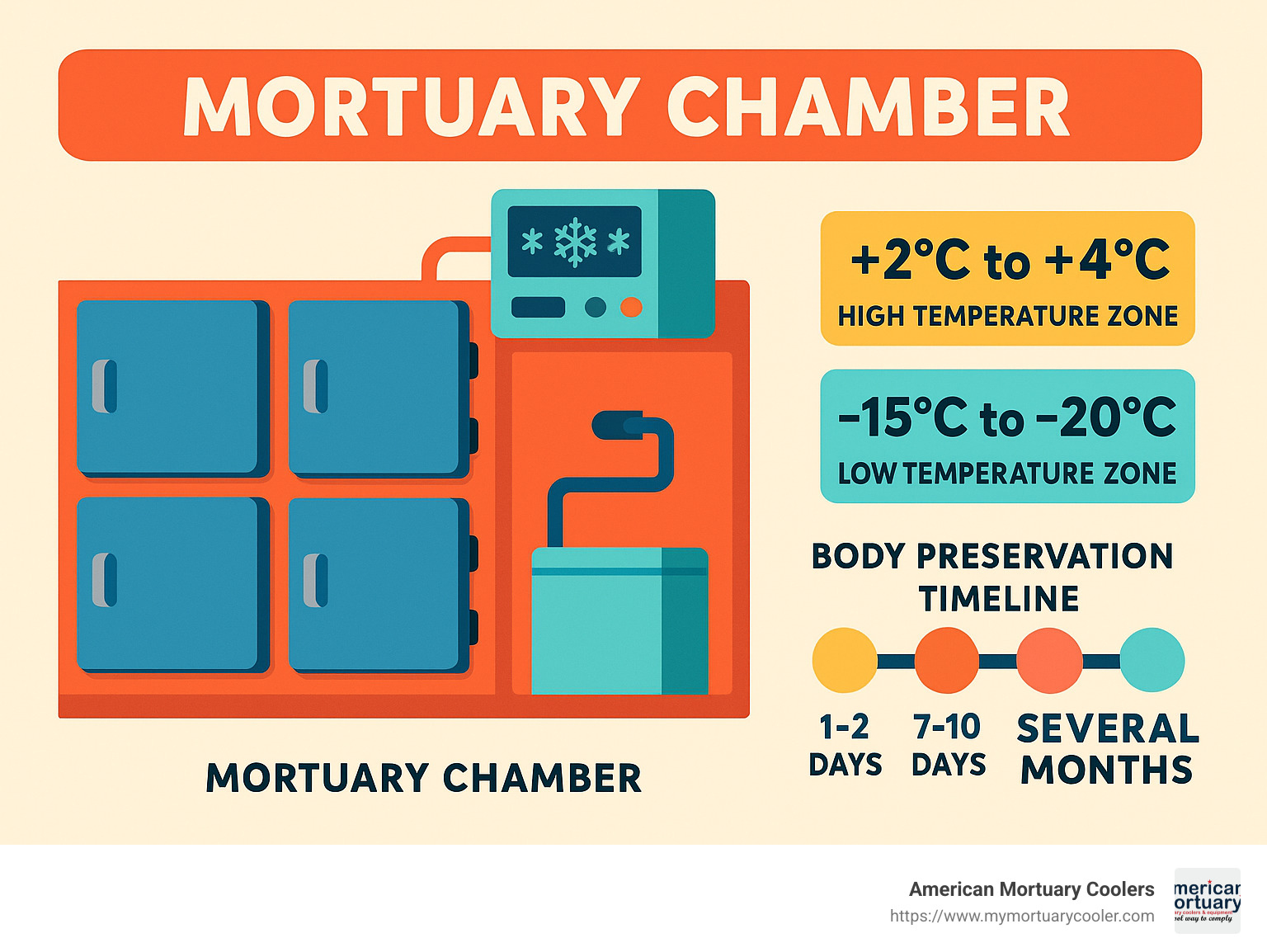
Similar topics to Mortuary chamber:
Mortuary Chamber: Definition, Purpose, and Public Health Role
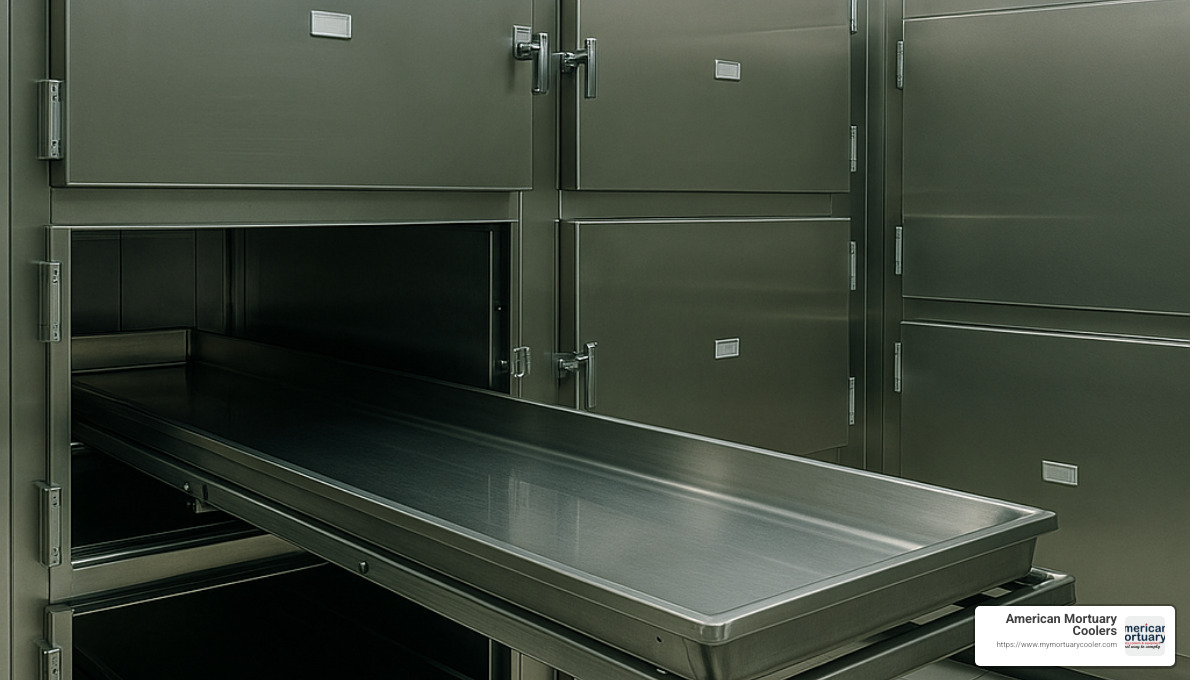
When a loved one passes away, their body begins a natural process that, without intervention, would progress quickly. This is where the mortuary chamber comes in – a specialized refrigeration unit that offers both practical necessity and dignified care for the deceased.
Think of a mortuary chamber as a carefully engineered environment where time slows down. These chambers aren't simply cold storage – they're sophisticated systems designed specifically for preserving human remains with respect and care. By maintaining precise temperatures, they create conditions where decomposition slows dramatically, giving families time to gather, grieve, and plan meaningful services.
At American Mortuary Coolers, we see these chambers as more than metal and cooling systems – they're essential tools that help funeral professionals provide compassionate care during life's most difficult moments.
Mortuary Chamber Primary Purpose
The heart of any mortuary chamber is its ability to preserve. Through carefully controlled cooling, typically between -5°C and +10°C (23°F to 50°F), these chambers dramatically slow the biological processes that would otherwise continue after death.
This cooling serves a crucial purpose – it inhibits bacterial growth. As one of our seasoned technicians often explains, "Nature's decomposition helpers – bacteria – simply can't thrive in these cold environments." This simple principle makes all the difference in preservation.
Beyond preservation, these chambers create breathing room in the timeline of final arrangements. Medical examiners gain the time needed for thorough examinations, funeral directors can prepare thoughtfully for services, and most importantly, families can take the time they need to gather and make decisions without rushing.
Under optimal conditions, a properly functioning mortuary chamber can maintain viewable remains for approximately 3-4 weeks, though this varies based on several factors including the condition of the remains when they arrive and the specific temperature maintained.
Mortuary Chamber vs. Morgue Refrigerator
You might hear these terms used interchangeably, but there are meaningful differences worth understanding.
The term mortuary chamber typically refers to the entire refrigerated space, while "morgue refrigerator" often describes the cabinet-style units with individual compartments. It's a subtle distinction in language that reflects different approaches to the same essential need.
The physical differences are more substantial. Cabinet-style units feature individual compartments accessed through doors – much like a filing system for the deceased. Walk-in chambers, by contrast, allow staff to enter the refrigerated space itself, providing access to multiple remains stored on racks or shelves.
Beyond these traditional options, the industry has developed specialized alternatives for unique situations. Temporary cooling plates, portable refrigeration units, and specialized transport coolers serve critical roles in field operations or disaster response scenarios when standard facilities aren't available.
We've noticed interesting patterns in how different facilities choose their equipment. Hospitals and medical examiners typically gravitate toward larger walk-in chambers due to their higher capacity needs and workflow requirements. Smaller funeral homes, working with space constraints and different caseloads, often find cabinet-style units offer the perfect balance of efficiency and proper preservation.
Each style serves the same fundamental purpose – creating a dignified, temporary space for the deceased while honoring both public health needs and the emotional needs of families during their time of loss.
Types and Capacities of Modern Mortuary Chambers
Whether you're running a small family funeral home or managing a county medical examiner's office, there's a mortuary chamber designed to meet your specific needs. Today's market offers everything from compact single-body units to expansive walk-in systems that can accommodate dozens of remains.
| Chamber Type | Typical Capacity | Approximate Dimensions | Best For | Approximate Cost |
|---|---|---|---|---|
| Single-Body Cabinet | 1 body | 86" × 36" × 36" | Small funeral homes, private viewing rooms | $6,000-$7,500 |
| 3-Body Cabinet | 3 bodies | 86" × 80" × 36" | Medium funeral homes, small hospitals | $8,000-$9,500 |
| 6-Body Cabinet | 6 bodies | 86" × 80" × 72" | Large funeral homes, regional hospitals | $9,750-$12,000 |
| Walk-in Chamber | 9-20+ bodies | Custom (modular) | Medical examiners, major hospitals, disaster response | $15,000-$50,000+ |
1-Body to 6-Body Cabinets
The bread and butter of the funeral industry, these compact units are what you'll find in most funeral homes across America. A mortuary chamber in this size range offers the perfect balance for smaller operations.
These cabinet-style units slide right into your existing space without major renovations. They're like the studio apartments of the mortuary world – efficient, practical, and surprisingly spacious inside. A typical 3-body cabinet measures about 86" long, 80" high, and 36" deep – compact enough to fit in most preparation rooms while giving you enough capacity to handle your caseload.
"Most of our clients running independent funeral homes with 100-200 cases a year find that a 3-body unit hits their sweet spot," our design team often explains. "It's not just about having enough space – it's about having the right amount of space for your workflow."
The beauty of these smaller units is their flexibility. They require only standard electrical connections, can be placed in various locations within your facility, and won't break the bank on initial investment or monthly power bills.
High-Capacity & Modular Systems
When your facility handles a higher volume of cases, our larger mortuary chamber options provide the scalability you need. Medical examiners' offices, teaching hospitals, and disaster response organizations often require these more substantial solutions.
Walk-in systems transform an entire room into a refrigerated space that can accommodate 9, 12, 15, or more bodies on multi-tier racks. We construct these rooms using insulated modular panels (typically 80mm thick with polyurethane insulation at 43-45 kg/m³ density) that provide excellent thermal efficiency while maintaining structural integrity.
The beauty of modular design is its adaptability. As your needs evolve, your chamber can evolve too. Need to add capacity next year? We can expand the system. Want to reconfigure the interior layout? No problem. These systems can incorporate multiple access doors, viewing windows, and specialized ventilation systems custom to forensic and medical requirements.
One of our recent installations for a county medical examiner featured a 6-body mortuary cabinet overview with customized rack heights to accommodate bariatric cases – a thoughtful detail that made their daily operations significantly more manageable.
Portable & Temporary Solutions
Life doesn't always happen in predictable places, and neither does death. For situations requiring mobility or temporary solutions, portable mortuary chambers provide dignity and proper care wherever they're needed.
Our mobile coolers can be trailer-mounted for rapid deployment to disaster sites. We've also developed containerized morgues – essentially shipping containers converted into fully-functional mortuary chambers, complete with generator backup for areas where power might be compromised.
"I'll never forget how crucial our containerized systems were during Hurricane Katrina," our emergency response specialist often recalls. "When local infrastructure was devastated, these units provided dignified temporary storage while proper identification and processing took place."
At American Mortuary Coolers, we pride ourselves on being able to deliver these portable solutions anywhere in the contiguous 48 states. Because even in the most challenging circumstances, the deceased deserve respectful care and their families deserve peace of mind.
Our emergency deployment systems are designed for quick assembly in field conditions, with clear instructions and minimal tools required. They represent our commitment to serving the death care industry not just in everyday operations, but in extraordinary circumstances as well.
How Mortuary Chambers Work: Key Features and Technology
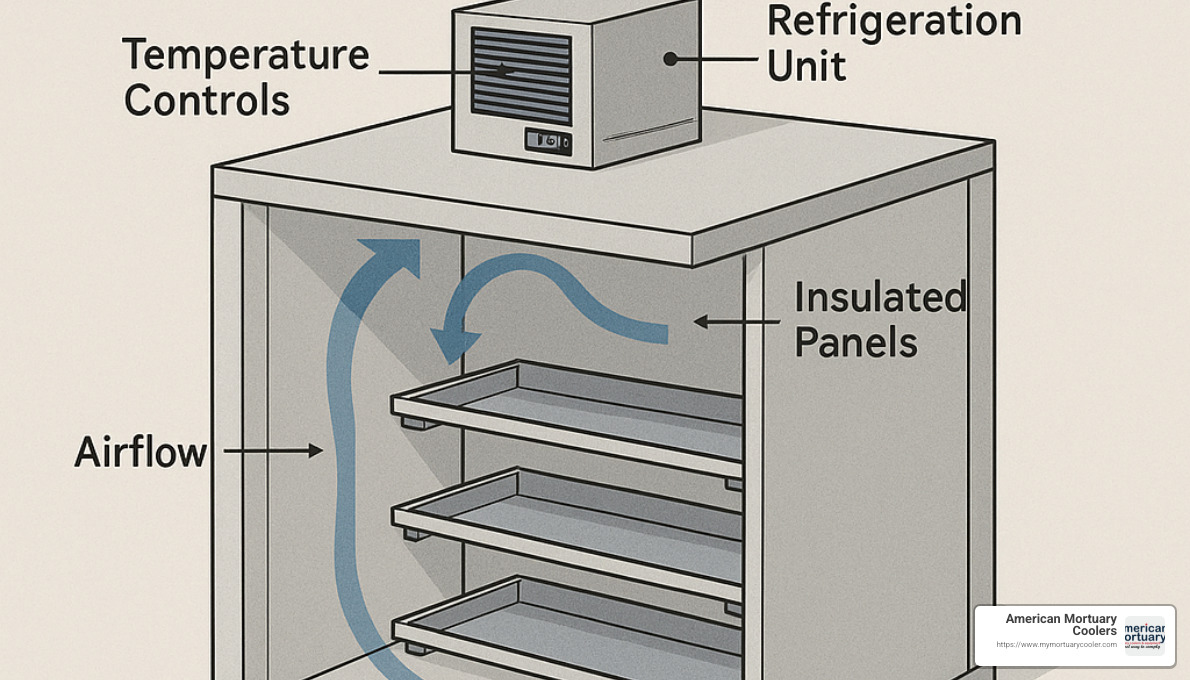
When you're considering a mortuary chamber for your funeral home, understanding how these remarkable units actually work makes all the difference. These aren't simply oversized refrigerators – they're specialized preservation systems designed with the unique needs of funeral professionals in mind.
Construction Materials & Insulation
The heart of any quality mortuary chamber starts with what it's made of. Think of it as building a fortress against heat and bacteria.
High-grade AISI 304 stainless steel forms the backbone of our chambers at American Mortuary Coolers. This isn't just about looking professional (though it certainly does) – this material stands up to years of harsh cleaning chemicals without corroding or degrading. After all, a chamber that can't be thoroughly sanitized isn't one you want in your facility.
The walls tell another important story. Our 80mm thick polyurethane foam panels (with densities of 40-45 kg/m³) create a thermal barrier that keeps the cold in and the heat out. These aren't your standard insulation panels – they're CFC-free and environmentally responsible while providing superior insulation.
"I like to tell funeral directors to think of these panels as the chamber's winter coat," says our design team lead. "The thicker and better-sealed that coat is, the less your cooling system has to work."
We take pride in using only UL-NSF approved materials that meet ASTM E84 standards for smoke and flame spread. It's not just about meeting regulations – it's about providing peace of mind for the funeral professionals who rely on our equipment daily.
Temperature & Humidity Control
The magic of a mortuary chamber happens in its cooling system. While the science is complex, the goal is simple: maintain a consistent, controlled environment that preserves with dignity.
Most of our standard preservation chambers keep temperatures between a sweet spot of -5°C and +10°C (23°F to 50°F). For special circumstances requiring longer preservation, our freezer units can reach -20°C (-4°F) or even lower.
But here's what many don't realize – consistency matters more than extreme cold. As our technical director often says, "Temperature swings are the enemy of preservation. A steady 2°C is far better than bouncing between -2°C and 6°C." That's why our digital control systems maintain stability within ±1°C, eliminating the fluctuations that can accelerate decomposition.
The thoughtfully engineered airflow patterns ensure every corner of the chamber receives the same cooling attention. No hot spots, no uneven preservation – just reliable, consistent performance that funeral directors can count on.
For those midnight worries about system failures, our alarm systems provide peace of mind. Many of our chambers now include remote monitoring capabilities – imagine getting an alert on your phone if temperatures drift outside acceptable ranges, even when you're away from the facility.
Safety, Hygiene & Ergonomics
A mortuary chamber isn't just about preserving remains – it's about supporting the people who work with it every day.
We've incorporated antimicrobial coatings on handles and frequent touch points because we understand the importance of reducing cross-contamination risks in funeral settings. The fully removable body trays make cleaning a straightforward process rather than an awkward challenge. These trays are engineered to support up to 350 pounds while remaining manageable for staff members of all sizes.
The ergonomics of our chambers reflect years of feedback from funeral professionals. Door handles positioned at comfortable heights, assisted-opening mechanisms that reduce strain, and properly designed tray slides that glide smoothly even under load – these details make a world of difference when you're using the equipment daily.
"We spent almost as much time designing how people interact with our chambers as we did on the cooling systems," notes our product development team. "Because the best technology in the world isn't helpful if it's a pain to use."
When it comes to cleaning, our chambers are designed for the real world of funeral service. The interior surfaces wipe down easily with standard disinfectants, door seals are accessible for regular inspection, and drainage systems are designed to prevent blockages that could compromise hygiene.
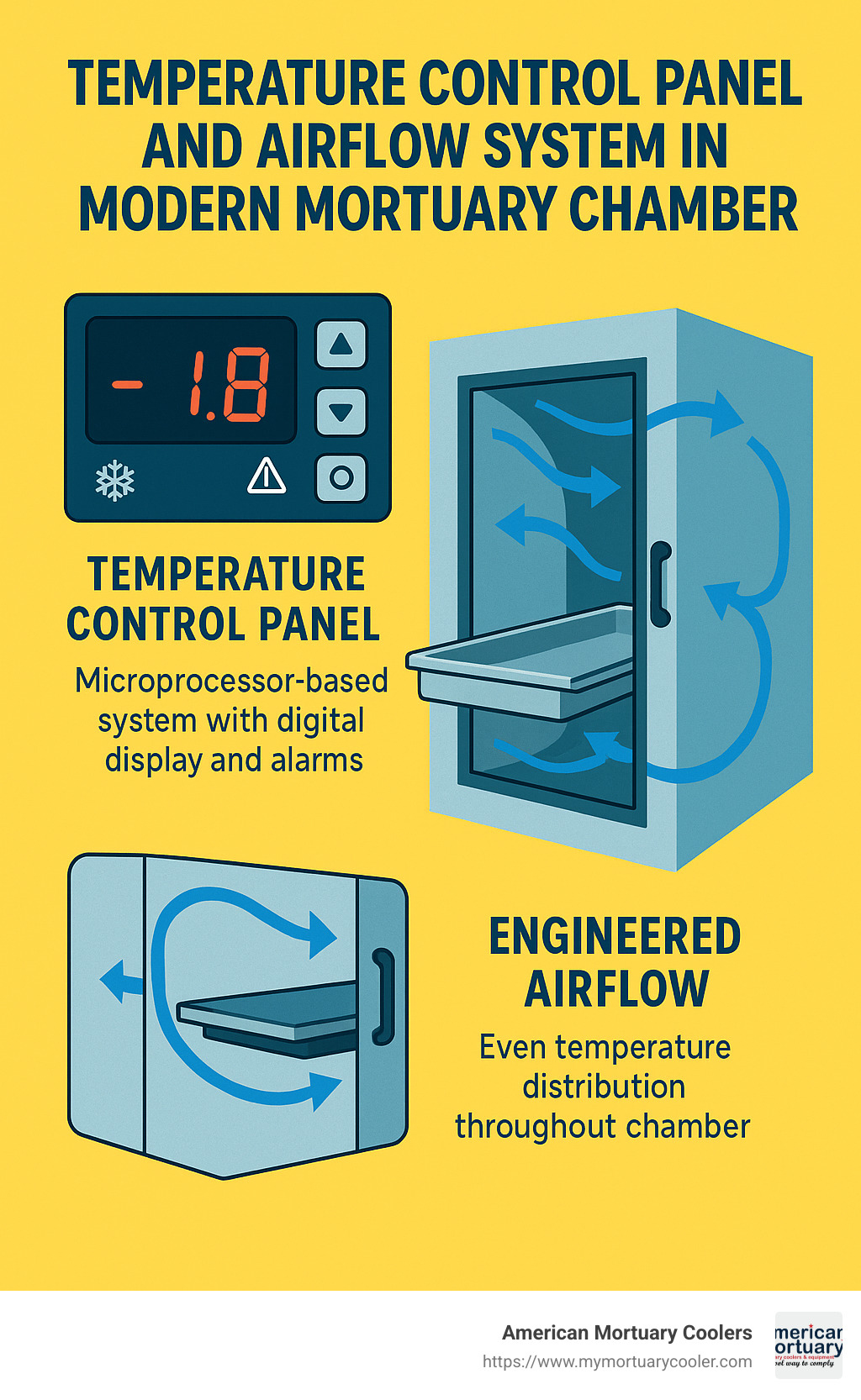
At American Mortuary Coolers, we understand that energy efficiency isn't just good for the planet – it's good for your bottom line. Our chambers comply with the Federal Energy Independence & Security Act requirements while keeping operational costs manageable. Many funeral homes report that upgrading to our modern, efficient systems pays for itself through energy savings within just a few years.
Selecting a Mortuary Chamber Manufacturer and Navigating Regulations
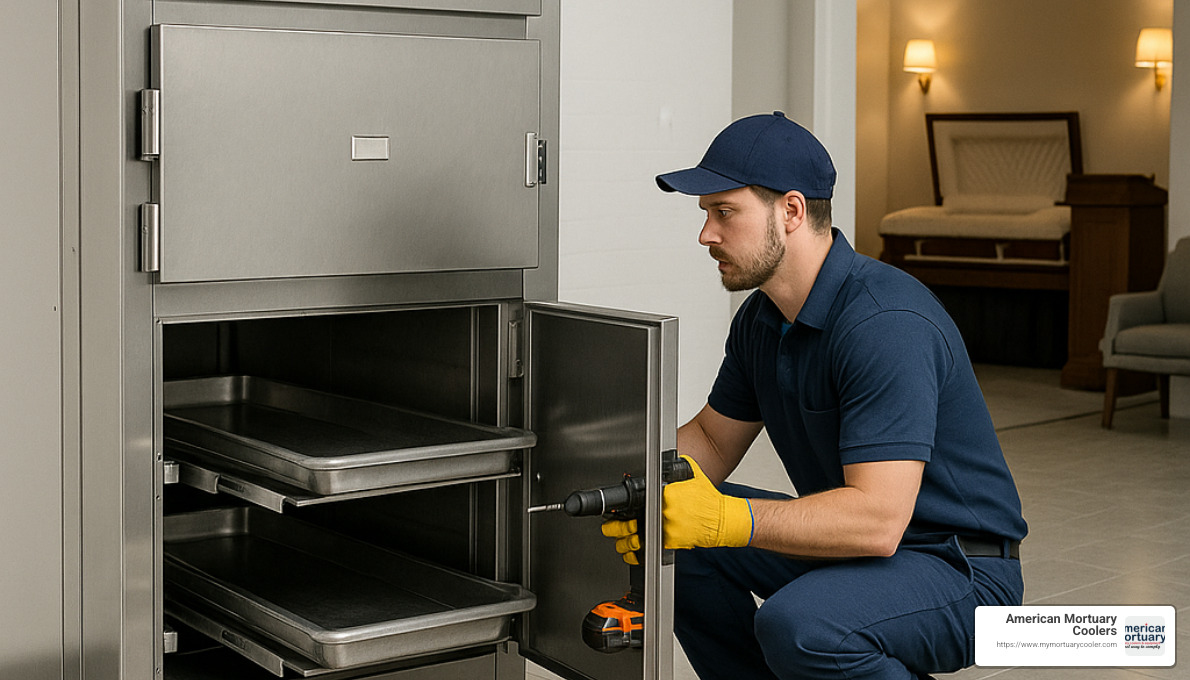
Investing in a mortuary chamber is a bit like choosing a business partner – you want reliability, quality, and someone who'll be there when you need them. For funeral homes, hospitals, and medical examiners' offices, this decision shapes not just your daily operations but also how well you'll steer the complex web of regulations that govern our industry.
Quality & Compliance Checklist
When I visit funeral homes across America, I often find directors who've learned the hard way that not all mortuary chambers are created equal. Beyond the shiny exterior, what really matters are the details that determine longevity and performance.
Look for door mechanisms that have been cycle-tested for at least 200,000 openings – that's about 20 years of regular use. It might seem excessive, but you'd be surprised how quickly those numbers add up in a busy facility.
The materials tell a story too. High-quality stainless steel meeting AISI 304 standards won't just look better longer; it'll withstand the daily cleaning with harsh disinfectants without corroding. Similarly, CFC-free insulation with proper density ratings isn't just better for the environment – it's better for your energy bills too.
"I can tell more about a manufacturer's commitment to quality by examining their welds than I can from their brochure," our quality manager often jokes. But there's truth there – those seemingly small details reveal volumes about what you can expect from your equipment over the long haul.
At American Mortuary Coolers, we don't just test our units; we document everything. Each chamber undergoes temperature stability verification and pressure testing before it leaves our facility. We're proud of this attention to detail – it's why our customers sleep better at night.
Shipping, Installation & After-Sales
Getting your mortuary chamber from our factory to your facility is a journey that requires careful planning. Our white-glove delivery service ensures your investment arrives without a scratch and is positioned exactly where you need it.
For our larger modular systems, professional installation isn't just recommended – it's essential. Proper sealing between panels, correct refrigeration line connections, and precise calibration make the difference between a chamber that hums along quietly for years and one that becomes a maintenance headache.
"Installation day is when the rubber meets the road," explains Tony, our lead installer with 15 years of experience. "A properly installed chamber should be so quiet you can barely tell it's running, and maintain temperatures within a single degree of your setting."
We don't consider our job done once the chamber is installed. Our team provides comprehensive training for your staff, covering everything from daily operation to basic troubleshooting. We understand that staff turnover happens, which is why we're always available for follow-up training when needed.
And should something ever go wrong, our nationwide network of service technicians means help is never far away. We maintain an extensive inventory of spare parts, ensuring minimal downtime if repairs are needed. After all, in our business, downtime isn't just inconvenient – it can be devastating.
Legal, Ethical & Safety Considerations
Navigating the regulatory landscape around mortuary chambers can feel like walking through a maze. Between OSHA requirements, state health codes, and local regulations, there's a lot to keep track of.
Most states have specific temperature requirements for storing human remains, typically between 2°C and 4°C (35°F-40°F). Documentation requirements vary too – some jurisdictions require regular temperature logs, while others focus more on chain-of-custody documentation.
Cultural and religious considerations add another layer of complexity. Some traditions have specific requirements about the handling and positioning of remains. At American Mortuary Coolers, we've designed chambers with adjustable interior configurations to accommodate these needs with dignity and respect.
Biohazard protocols aren't just good practice – they're essential for safety and compliance. Clear procedures for handling potential leakage or contamination should be established before they're needed, not during a crisis.
"Understanding regulations isn't the most exciting part of our business," admits our compliance specialist, "but it's just as important as understanding the technical specifications. We see ourselves as guides through this complex landscape."
We stay current with evolving regulations across all states we serve, providing guidance to ensure our customers remain fully compliant. Our documentation includes recommended operating procedures aligned with best practices for safety, dignity, and regulatory compliance.
When you partner with American Mortuary Coolers, you're getting more than just equipment – you're gaining an ally who understands the unique challenges of the funeral industry and is committed to helping you steer them successfully. After all, we believe that the right equipment, properly installed and maintained, allows you to focus on what really matters: providing compassionate care to families during their most difficult moments.
For a deeper dive into selection criteria, check out our comprehensive guide to Everything You Need to Know About Choosing a Mortuary Cooler.
Evolution of Body Storage: From Ancient Burial Chambers to High-Tech Freezers
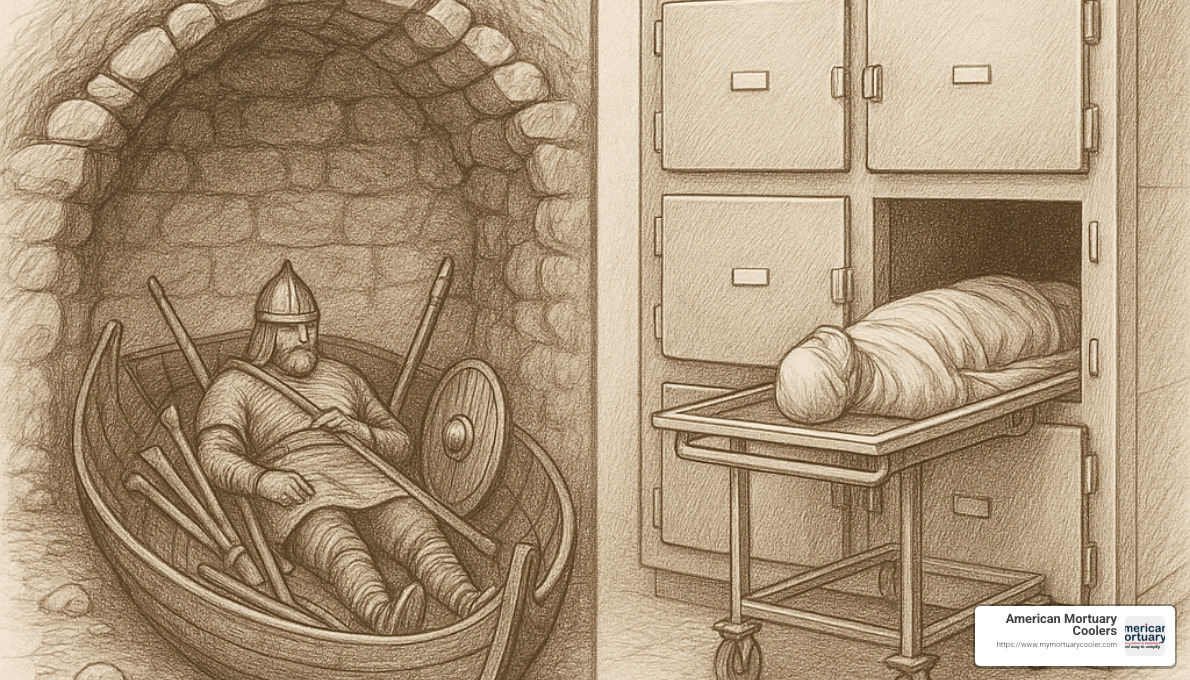
The journey of how we've cared for our departed tells a fascinating story of human ingenuity and respect. From elaborate burial chambers of ancient civilizations to today's technologically advanced mortuary chambers, our methods have evolved dramatically while maintaining one constant: the desire to honor those who have passed.
Lessons from Ancient Mortuary Chambers
Long before refrigeration, our ancestors developed remarkable solutions for preserving and protecting their dead.
The Viking chamber-graves of the late 800s CE reveal much about social hierarchy and changing religious practices. These wooden structures, typically measuring 2 × 3 meters, were reserved for society's elite. Denmark alone has yielded about 60 such chamber-graves, which historians believe emerged partly in response to Christianity's growing influence. These chambers weren't merely functional—they told stories about who the deceased was in life through carefully placed artifacts and structural elements.
In Egypt, the pyramid chambers represent perhaps history's most famous dedication to preserving the dead. The engineering was remarkably sophisticated, with strategic ventilation shafts and humidity control features that modern architects still study with wonder. The King's Chamber in the Great Pyramid showcases this dedication, with nine massive granite blocks weighing 40-50 tons each—a testament to the extraordinary value placed on creating a suitable eternal resting place.
The Mycenaean chamber tombs of the Bronze Age demonstrate how architecture could symbolize spiritual transitions. These ingenious structures featured a three-part design: the dromos (entrance passage), stomion (threshold), and thalamos (chamber). Scholars describe this layout as creating a "boundary zone between the living and the dead"—a physical representation of the soul's journey. With approximately 300 such tombs finded at Mycenae alone, these structures were clearly central to their burial practices.
By the 19th century, a very different challenge led to innovative solutions. The morthouses of this era addressed the serious problem of body-snatching for medical research. "This circular stone building, called a morthouse, houses a revolving wheel upon which a coffin would be placed & kept under lock and key," explains one historical account. These clever structures protected the deceased until natural decomposition made them unsuitable for anatomical study—a practical solution to a macabre problem.
"What strikes me most about historical preservation methods is how they balanced practical needs with deep spiritual beliefs," shares our historical consultant. "Today's mortuary chambers continue this tradition, just with more advanced technology."
Modern Innovations & Future Trends
Today's refrigerated mortuary chambers would seem miraculous to our ancestors, yet they're evolving at an impressive pace with several exciting developments on the horizon.
Remote monitoring capabilities have transformed how facilities manage their chambers. IoT-enabled sensors now provide continuous temperature tracking accessible through smartphone apps, sending instant alerts if conditions deviate from ideal parameters. This technology has been particularly valuable for smaller funeral homes where staff can't be present 24/7.
The push for energy efficiency has yielded impressive results across the industry. Modern compressors and advanced insulation materials have reduced energy consumption by up to 40% compared to models from just a decade ago. For funeral homes watching their bottom line, these savings add up significantly over a chamber's lifetime while reducing environmental impact.
Environmental consciousness is driving the adoption of green refrigerants throughout the industry. We're moving away from hydrofluorocarbons (HFCs) toward natural alternatives like R-290 (propane) and R-600a (isobutane) that have dramatically lower global warming potential. At American Mortuary Coolers, we're proud to be at the forefront of this transition.
The concept of modular growth has revolutionized how facilities plan for the future. Rather than replacing entire systems when needs change, contemporary designs allow for expanding capacity through modular additions. "It's like having a future-proof investment," as one of our clients recently put it. This approach reduces waste and makes good financial sense.
With increasing climate uncertainty, solar readiness has become a valuable feature in newer units. Models designed to operate on DC power can connect directly to solar energy systems, ensuring operation during grid outages. This capability provides peace of mind for facilities in areas prone to weather emergencies.
"I'm most excited about the 'smarter' systems we're developing," shares our engineering director. "The future mortuary chambers will not only maintain perfect conditions but can actually self-diagnose potential issues before they become problems. It's like having a technician constantly monitoring your equipment."
At American Mortuary Coolers, we accept these innovations while maintaining our commitment to quality craftsmanship. Our latest models incorporate energy-efficient designs, environmentally friendly refrigerants, and intelligent monitoring systems. We're also exploring 3D-printed replacement parts to minimize maintenance downtime and developing custom configurations that accommodate bariatric remains with dignity and respect.
The ancient Egyptians would surely be impressed by how far we've come—and perhaps pleased to see that caring for the deceased with respect and ingenuity remains central to our approach.
Frequently Asked Questions about Mortuary Chambers
When I sit down with funeral directors and medical facility managers to discuss mortuary chambers, certain questions pop up time and again. After years of helping professionals find the right solutions at American Mortuary Coolers, I've gathered these common questions—and their answers—to help you make informed decisions.
What temperature should a mortuary chamber maintain?
The sweet spot for a standard mortuary chamber is between 2°C and 4°C (35°F to 39°F). This range hits the perfect balance—cold enough to slow decomposition by inhibiting bacterial growth, but not so cold that it freezes the remains.
Think of it as the Goldilocks zone of preservation—just right for maintaining the condition of the deceased while allowing for proper preparation later.
For special circumstances or longer-term storage, we do offer freezer units that maintain temperatures around -20°C (-4°F). However, most funeral homes prefer refrigeration over freezing for very practical reasons. Refrigerated remains are much easier to embalm, as freezing can cause tissue damage that complicates the preparation process. Plus, the thawing process itself can create additional issues for embalmers.
As one of our longtime customers once told me, "Too cold creates as many problems as too warm—it's all about finding that perfect middle ground."
How often must a mortuary chamber be serviced?
I always tell our clients that a mortuary chamber is like any high-performance equipment—regular maintenance prevents unexpected problems. The last thing any funeral director needs is a system failure during a busy week.
A thorough maintenance schedule typically includes:
- Quarterly check-ups of door seals, drainage systems, and temperature calibration
- Semi-annual cleaning of condenser coils to maintain energy efficiency
- Annual comprehensive service by qualified technicians who understand the unique requirements of mortuary refrigeration
I've seen how a simple maintenance log can save headaches during regulatory inspections. It's a small step that demonstrates your commitment to proper care and compliance.
At American Mortuary Coolers, we understand that service availability matters. That's why we offer customized service contracts with scheduled maintenance visits and priority emergency response across all our service regions—from the Southeast to the Pacific coast. When a client in Oklahoma called us with an urgent issue last summer, we had a technician on-site within hours, not days.
Can mortuary chambers be expanded after installation?
This is a question of planning for the future, and the answer depends entirely on what type of mortuary chamber you have:
Cabinet-style units—those standalone refrigerators with individual compartments—generally can't be expanded themselves. When capacity needs grow, most facilities add additional units. They're like building blocks for your preparation room.
Modular walk-in chambers offer much more flexibility. These systems use insulated panels that can often be reconfigured or expanded, provided you have the physical space and your refrigeration system can handle the increased volume.
I remember working with a growing funeral home in Texas that started with a modest 6-body chamber. Within three years, their case volume had doubled. Because we had initially designed their system with growth in mind—including a slightly oversized refrigeration unit—we were able to expand their chamber with minimal disruption to their operations.
The key takeaway? Think ahead when planning your facility. Allocating extra space and ensuring adequate electrical capacity might seem unnecessary today, but it could save you thousands tomorrow.
For facilities with seasonal fluctuations or occasional surges, we often recommend a hybrid approach—a permanent chamber sized for your average needs, with portable units ready to deploy during busier periods or emergency situations.
Conclusion
The mortuary chamber stands as a critical piece of infrastructure in modern death care, representing the intersection of technical precision and compassionate service. From ancient burial chambers that honored the deceased through architectural grandeur to today's sophisticated refrigeration systems that preserve with digital precision, the evolution of these specialized environments reflects our enduring commitment to dignified treatment of the dead.
When I speak with funeral directors about their equipment needs, I'm always reminded that behind every technical specification lies a human story. Families need time to gather from distant places. Professionals require optimal conditions to perform their sacred work. Communities expect responsible management of public health considerations. These human elements drive every design decision we make at American Mortuary Coolers.
Selecting the right mortuary chamber isn't just about buying equipment—it's about making an investment in your facility's ability to serve families with dignity and care. The right chamber balances capacity needs with space constraints, maintains energy efficiency while meeting compliance requirements, and fits seamlessly into your workflow while supporting your staff's daily operations.
I've seen how proper installation, regular maintenance, and comprehensive staff training transform a good chamber into an exceptional one. These elements aren't extras—they're essential components of the overall value proposition that savvy funeral professionals recognize and appreciate.
At American Mortuary Coolers, we're proud of our Tennessee roots and our ability to serve funeral homes across all 48 contiguous states. Our American-made chambers combine durability, efficiency, and thoughtful design whether you need a compact single-body unit for your small-town funeral home or an expansive walk-in system for a busy medical examiner's office.
The future of mortuary chambers looks promising, with innovations in refrigeration technology, remote monitoring, and energy efficiency continuing to improve functionality while reducing environmental impact. These advances ensure that even as cultural practices around death and remembrance evolve, the fundamental need for respectful preservation remains addressed with increasing sophistication and care.
For more information about custom mortuary chamber solutions for your facility, contact American Mortuary Coolers today. Our team of specialists is ready to help you steer the selection process, ensuring you receive equipment that meets your specific needs while upholding the highest standards of the profession.
American Mortuary Coolers – morgue coolers & forensic refrigeration
















